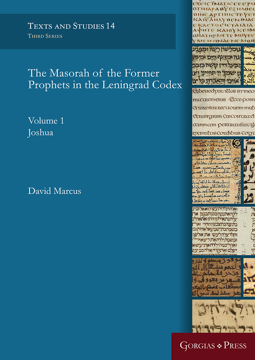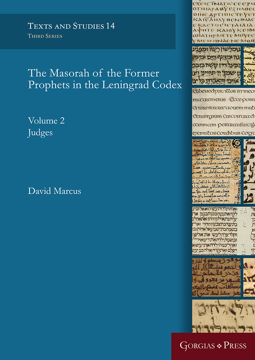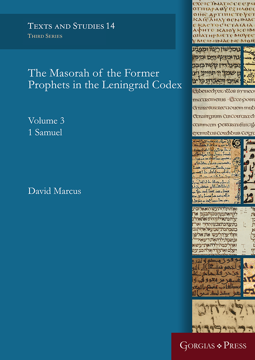The Life of Sallara and his Mother Elishbah
East Syrian Christianity in Northern Mesopotamia from Late Antiquity to Early Islam
Series: Texts from Christian Late Antiquity 81
ISBN: 978-1-4632-4802-4
The first ever edition and translation of a biography of Sallara and his mother Elishbah, exploring both its local context – their asceticism and deeds in North Mesopotamia in the early 7th century – and the geopolitical events underway in the Middle East: war between Persia and Byzantium, and the rise of Islam in the region.
$114.95 (USD) $91.96 (USD)
Jacob of Sarug's Homily on the Entrance of Our Lord into Sheol
Series: Texts from Christian Late Antiquity 82
ISBN: 978-1-4632-4815-4
Recognized as a saint by both Chalcedonian and non-Chalcedonian Christians alike, Jacob of Sarug (d. 521) produced many narrative poems that have rarely been translated into English. Of his reported 760 metrical homilies, only about half survive. In this homily, On the Entrance of Our Lord into Sheol, Jacob tells with great power the invincibility of Sheol and how Christ gave His life to enter into Sheol like any other dead human so that He might conquer it.
$34.95 (USD) $27.96 (USD)
Journal of Language Relationship 22/1-2
Series: Journal of Language Relationship 22/1-2
ISBN: 978-1-4632-4823-9
The Journal of Language Relationship is an international periodical publication devoted to the issues of comparative linguistics and the history of the human language. The Journal contains articles written in English and Russian, as well as scientific reviews, discussions and reports from international linguistic conferences and seminars.
$74.00 (USD) $59.20 (USD)
The Muslim Floating Population and Cultural Forms in Contemporary China
Series: Gorgias Islamic Studies 25
ISBN: 978-1-4632-4831-4
The influx of Uyghur migrant workers from rural areas into mainland cities in China has steadily increased since the 1980s. These migrants face unique challenges, with differences in language, religious belief, customs, values and behavior, and their transition to urban environments is often accompanied by psychological barriers and economic burdens. This study aims to analyze the living conditions and challenges encountered by these 'floating' populations, and to understand the mechanisms that facilitate or hinder their integration.
$95.00 (USD) $76.00 (USD)
The Masorah of the Former Prophets in the Leningrad Codex (Joshua)
Vol. 1: Joshua
By David Marcus
Series: Texts and Studies (Third Series) 14
ISBN: 978-1-4632-0598-0
This work represents the first time that a major part of the masorah of the great Leningrad Codex, that of the Former Prophets, is being published with an English translation and commentary. Almost nine-thousand notes are transcribed and annotated with biblical references.
$194.00 (USD)
The Lexical Profile of the Suras (vol. 15)
By Elie Wardini
Series: Gorgias Islamic Studies 22
ISBN: 978-1-4632-4677-8
The aim with the present series, The Quran: The Lexical Profile of the Suras, is to present key data related to the lexicon of the suras of the Quran, in terms of Key Word distribution and lexical associations within each sura. The digital text used for this purpose is the Uthmani text of the Tanzil Quran Text. All vocalized Arabic text is quoted unaltered in any shape or form from the Tanzil text. Unvocalized Arabic text and transcriptions are my own. The Key Words are always referenced by their lemma and are sorted alphabetically according to Arabic and UNICODE order with minor adjustments for consistency. In lemmatizing the words, no attention has been given to the semantics of each word. Only on rare occasion have similar forms of words or proper nouns been separated in order to avoid confusion. In assigning each word a lemma, Classical dictionaries and Quran commentaries, as well as modern Quran dictionaries have been consulted.
$216.00 (USD) $172.80 (USD)
The Masorah of the Former Prophets in the Leningrad Codex (Judges)
Vol. 2: Judges
By David Marcus
Series: Texts and Studies (Third Series) 14
ISBN: 978-1-4632-0599-7
This work represents the first time that a major part of the masorah of the great Leningrad Codex, that of the Former Prophets, is being published with an English translation and commentary. Almost nine-thousand notes are transcribed and annotated with biblical references.
$178.00 (USD)
The Masorah of the Former Prophets in the Leningrad Codex (1 Samuel)
Vol. 3: 1 Samuel
By David Marcus
Series: Texts and Studies (Third Series) 14
ISBN: 978-1-4632-0597-3
This work represents the first time that a major part of the masorah of the great Leningrad Codex, that of the Former Prophets, is being published with an English translation and commentary. Almost nine-thousand notes are transcribed and annotated with biblical references.
$198.00 (USD)
The Masorah of the Former Prophets in the Leningrad Codex (2 Samuel)
Vol. 4: 2 Samuel
By David Marcus
Series: Texts and Studies (Third Series) 14
ISBN: 978-1-4632-0602-4
This work represents the first time that a major part of the masorah of the great Leningrad Codex, that of the Former Prophets, is being published with an English translation and commentary. Almost nine thousand notes are transcribed and annotated with biblical references.
$140.00 (USD)
The Masorah of the Former Prophets in the Leningrad Codex (2 Kings)
Vol. 6: 2 Kings
By David Marcus
Series: Texts and Studies (Third Series) 14
ISBN: 978-1-4632-0604-8
This work represents the first time that a major part of the masorah of the great Leningrad Codex, that of the Former Prophets, is being published with an English translation and commentary. Almost nine-thousand notes are transcribed and annotated with biblical references.
$182.00 (USD)









